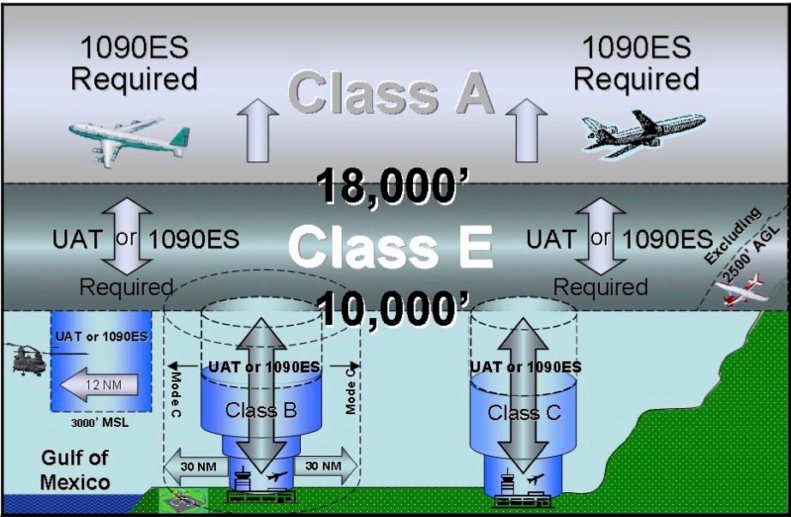
ADS-B
As many US pilots now have heard, after Jan 1st 2020 ADS-B OUT is now a mandatory requirement in the US.
The full description of where ADS-B is now required can be found under the Federal Regulations of 14 CFR 91.225. As the regulations listed in 91.225 can be confusing to decipher, below is the most simplistic description of the airspace in which this equipment is now required.
ADS-B is required for these following flight ops:
Flight in Class A airspace (18,000ft)
Flight in (OR ABOVE) Class B and C airspace
Flight in a Mode-C Veil (the 30NM ring surrounding Class B airports such as KSFO, KLAX, KJFK ect)
Flight above 10,000 FT (with the exception of flights above 10,000ft MSl but less than 2,500AGL for flights in mountainous regions like the Rockies)
To further clarify, for flights above 18,000ft (Class A airspace) a specific type of ADS-B out box is required. For these flights the aircraft must be equipped with an ADS-B OUT on 1090ES. If you fly a small GA aircraft and never plan on operating at altitudes of 18,000ft your aircraft can be equipped with a Universal Access Transceiver (978 MHz).
For pilots who find themselves in the predicament of having to operate in the above listed airspace in an aircraft that is not equipped with ADS-B the FAA has created the “ADS-B Deviation Authorization Preflight Tool (ADAPT)” The ADAPT program will allow a pilot to request authorization to fly a non ADS-B equipped aircraft in airspace normally requiring ADS-B equipment.
The application for ADAPT MUST be made online at least one hour but not more than 24 hours before the flight (https://sapt.faa.gov/adapt-start.php)
The FAA has stated that they will not allow for requests to be made in flight via ATC frequency and they plan on closely monitoring the program to ensure that ADAPT is not abused or misused with frequent requests by the same users.
A good rule to follow is when in doubt of the type of airspace you will be flying into, always ensure the aircraft is properly equipped with ADS-B OUT equipment.
As many US pilots now have heard, after Jan 1st 2020 ADS-B OUT is now a mandatory requirement in the US.
The full description of where ADS-B is now required can be found under the Federal Regulations of 14 CFR 91.225. As the regulations listed in 91.225 can be confusing to decipher, below is the most simplistic description of the airspace in which this equipment is now required.
ADS-B is required for these following flight ops:
Flight in Class A airspace (18,000ft)
Flight in (OR ABOVE) Class B and C airspace
Flight in a Mode-C Veil (the 30NM ring surrounding Class B airports such as KSFO, KLAX, KJFK ect)
Flight above 10,000 FT (with the exception of flights above 10,000ft MSl but less than 2,500AGL for flights in mountainous regions like the Rockies)
To further clarify, for flights above 18,000ft (Class A airspace) a specific type of ADS-B out box is required. For these flights the aircraft must be equipped with an ADS-B OUT on 1090ES. If you fly a small GA aircraft and never plan on operating at altitudes of 18,000ft your aircraft can be equipped with a Universal Access Transceiver (978 MHz).
For pilots who find themselves in the predicament of having to operate in the above listed airspace in an aircraft that is not equipped with ADS-B the FAA has created the “ADS-B Deviation Authorization Preflight Tool (ADAPT)” The ADAPT program will allow a pilot to request authorization to fly a non ADS-B equipped aircraft in airspace normally requiring ADS-B equipment.
The application for ADAPT MUST be made online at least one hour but not more than 24 hours before the flight (https://sapt.faa.gov/adapt-start.php)
The FAA has stated that they will not allow for requests to be made in flight via ATC frequency and they plan on closely monitoring the program to ensure that ADAPT is not abused or misused with frequent requests by the same users.
A good rule to follow is when in doubt of the type of airspace you will be flying into, always ensure the aircraft is properly equipped with ADS-B OUT equipment.
